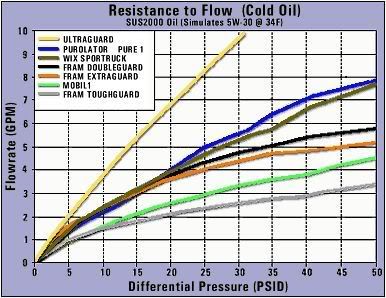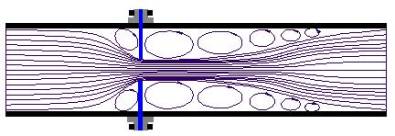Originally Posted By: hofcat
From what you describe they do seem to have the right test rig and even heated the oil to operating temperature. This is far beyond the capabilities of most if not all members of this forum unless they work in the automotive engineering industry. This is what confounds me the most. The data is not what would normally be expected based on basic engineering principals and assumptions. If it is accurate then there is something more complex going on in the filter that has never been explained on any forum or industry paper I have seen. A possible explanation may be the filter media resistance coefficient is not fixed like that of the inlet or exit holes to the filter but is a value that changes with fluid velocity due to some kind distortion of the media. That is the pores in the filter media may some how expand as the fluid velocity increases. This is just speculation on my part. Another effect not discussed yet is transition from laminar flow to turbulent flow. I assumed the flow is always turbulent. I do not see the characteristics of a laminar to turbulent flow transition in the data provided.
Your theory in red (especially the bold red) above is what I would think also. This could also explain why filtering efficiency seems to suffer as the pressure and flow rate increases in a filter.
As I said earlier ... it seems the classic flow equation doesn't firmly describe filter flow.
As you know ... theory and reality don't always coincide (per the classic equations). Theory and equations need to be tweaked to meet reality if you believe the experimental data. I think this is the case with filter flow characteristics.
From what you describe they do seem to have the right test rig and even heated the oil to operating temperature. This is far beyond the capabilities of most if not all members of this forum unless they work in the automotive engineering industry. This is what confounds me the most. The data is not what would normally be expected based on basic engineering principals and assumptions. If it is accurate then there is something more complex going on in the filter that has never been explained on any forum or industry paper I have seen. A possible explanation may be the filter media resistance coefficient is not fixed like that of the inlet or exit holes to the filter but is a value that changes with fluid velocity due to some kind distortion of the media. That is the pores in the filter media may some how expand as the fluid velocity increases. This is just speculation on my part. Another effect not discussed yet is transition from laminar flow to turbulent flow. I assumed the flow is always turbulent. I do not see the characteristics of a laminar to turbulent flow transition in the data provided.
Your theory in red (especially the bold red) above is what I would think also. This could also explain why filtering efficiency seems to suffer as the pressure and flow rate increases in a filter.
As I said earlier ... it seems the classic flow equation doesn't firmly describe filter flow.
As you know ... theory and reality don't always coincide (per the classic equations). Theory and equations need to be tweaked to meet reality if you believe the experimental data. I think this is the case with filter flow characteristics.











